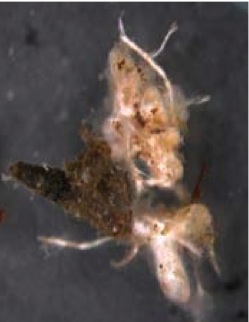PESTS AND DISEASES OF FORESTRY IN NEW ZEALAND
Mycorrhizas and seedlings
Scion is the leading provider of forest-related knowledge in New Zealand
Formerly known as the Forest Research Institute, Scion has been a leader in research relating to forest health for over 50 years. The Rotorua-based Crown Research Institute continues to provide science that will protect all forests from damage caused by insect pests, pathogens and weeds. The information presented below arises from these research activities.
From Forest Health News No. 178, October/November 2007.

The majority of plants are dependent on a symbiotic relationship with soil fungi called “mycorrhizas”, which enables an increased uptake of nutrients and water and may protect the plant from pathogens. Plant health therefore increases, and the fungus in turn receives carbon from its host. There are several different types of mycorrhizal association. The symbiotic type found on our important plantation trees Pinus radiata and Pseudotsuga menziesii is called “ectomycorrhiza” (ECM); in this type the fungus grows around the root tips and forms a visible covering called a mantle (Figure 1). A PhD study at Ensis, Rotorua, investigated the ECM communities associated with P. radiata at Te Ngae Nursery, Rotorua, and in stands of several ages in Kaingaroa Forest in 2005 and 2006, with a special focus on the actual fungi colonising root tips. Part of this study investigated the fate and survival rate of fungal species colonising seedlings in the nursery in the first years after planting on a clearcut site. It is known that clearcutting reduces ECM diversity as it removes the host and hence the carbon source for the fungus. Furthermore this forestry practice alters the soil conditions, removes the organic layer through the clearcutting, and turns the site into a harsh environment for re-establishment. Mycorrhizal colonisation is imperative for the establishment of P. radiata as the tree is unable to grow without the fungal symbiosis; after planting it is even more important to have strong mycorrhizal development to facilitate the establishment of the seedlings.
The species found in the nursery were Rhizopogon rubescens, Hebeloma sp. (Figure 2), Tuber sp., and Wilcoxina mikolae. Seedlings were planted on a clearcut site in Kaingaroa Forest and ECM on the seedlings were assessed on a monthly basis for a year. In addition, a 2- and a 7-year-old plantation were assessed. The study found that all nursery ECM were still present and dominant during the first year after planting. A few non-nursery ECM species were found on the root tips after 1 year, but these were of only minor incidence. The species R. rubescens (Figure 1) was dominant in the nursery and for the first year after planting. In a study in Spain on the differential responses of certain fungal species to environmental factors and their role in the mycorrhization of P. radiata seedlings (Duñabeitia et al. 2004), R. rubescens was found to be the most beneficial species for P. radiata seedlings in terms of colonisation, growth promotion, and tolerance to adverse environmental conditions. This makes it a desirable species to have on nursery seedlings. The ECM species composition was significantly different in the 7-year-old plantation and non-nursery species dominated. Compared to overseas studies we found this changeover in species was later and it took longer for new fungal species to colonise the root tips.


The overall ECM diversity on New Zealand’s plantation species is low compared to overseas native forests and plantations, and diversity is even lower in the clearcut environment (Jones et al. 2003). The current study has shown that it takes more than 3 years after planting for ECM fungi from nearby plantation forests to establish themselves as successful colonisers on the young trees. The colonisation by forest ECM was slower than reported in other studies (Dahlberg & Stenstrom 1991; Menkis et al. 2007). This finding implies that it is important to have ECM species from the nursery present on the root tips when the seedlings are planted in order to bridge the gap until the forest ECM colonise the root tips and take over the important role of nutrient and water uptake.
Viable inoculum for the nursery fungi is also present in the soil surrounding the roots and it is recommended that not all of the nursery soil should be removed from the seedling to ensure the colonisation of seedling roots by the ECM fungi at planting.
Katrin Walbert
References
Dahlberg, A.; Stenstrom, E. 1991: Dynamic changes in nursery and indigenous mycorrhiza of Pinus sylvestris planted out in forest and clearcuts. Plant and Soil 136: 73–86.
Duñabeitia, M.K.; Hormilla, S.; Garcia-Plaxaola, J.I.; Txarterina, K.; Arteche, U.; Becerril, J.M. 2004: Differential responses of three fungal species to environmental factors and their role in the mycorrhization of Pinus radiata D. Don. Mycorrhiza 14: 11–18.
Jones, M.D.; Durall, D.M.; Cairney, J.W.G. 2003: Ectomycorrhizal fungal communities in young forest stands regenerating after clearcut logging. New Phytologist 157: 399–422.
Menkis, A.; Vasiliauskas, R.; Taylor, A.F.; Stenlid, J.; Finlay, R.D. 2007: Afforestation of abandoned farmland with conifer seedlings inoculated with three ectomycorrhizal fungi — impact of plant
performance and ectomycorrhizal community. Mycorrhiza 17: 337–348
This information is intended for general interest only. It is not intended to be a substitute for specific specialist advice on any matter and should not be relied on for that purpose. Scion will not be liable for any direct, indirect, incidental, special, consequential or exemplary damages, loss of profits, or any other intangible losses that result from using the information provided on this site.
(Scion is the trading name of the New Zealand Forest Research Institute Limited.)



